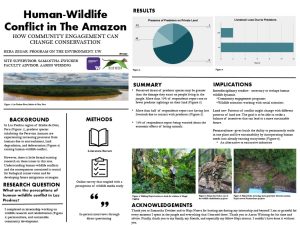Human Wildlife Conflict In The Peruvian Amazon
With extractive industries growing in Las Piedras region of Madre de Dios, Peru, it is important to recognize the impact on the sensitive ecosystems that predator species are apart of. Decreased home-ranges and increased presence of humans is causing more human-wildlife conflict than ever. The aim of the study was to identify which animals are conflicting most with humans and what kinds of conflict this overlap is causing. I created a survey to conduct qualitative interviews with the people living along Las Piedras River. This survey collected demographic information as well as work history and sizes of land ownership. A “presence/absence” question as well as questions that identify which animals these people are coming into conflict with will help determine which kinds of mitigation strategies are necessary. The main results show that ocelots and boas are the main perpetrators of human wildlife conflict. This is important to know because we can use what we know about the ecology of these species to form a greater understanding of the problem. The survey also revealed that the perceived threat of predator species is greater than the threat they actually pose. This coupled with the knowledge that agricultural practices are exacerbating the conflict tells us that education around alternative agriculture practices could be a part of the solution. It is possible that patterns of conflict will change with different patterns of land use. An interdisciplinary approach will be necessary when developing mitigation strategies.
